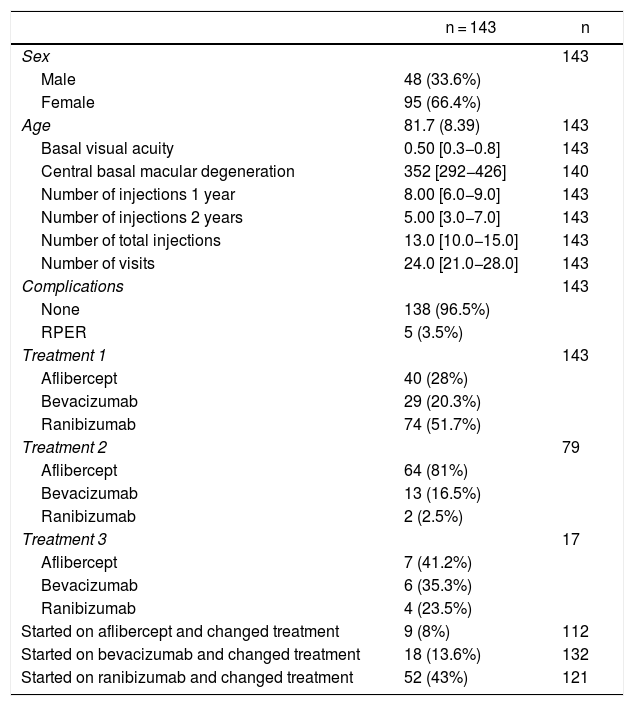The prognosis of age-related macular degeneration (AMD) has improved significantly since the advent of antiangiogenic treatments. However, several «real life» studies have shown lower number of injections and a markedly worse visual prognosis than pivotal clinical trials.
ObjectiveTo assess the effectiveness and safety of the treatment of neovascular AMD and analyse clinical factors related to the functional and structural prognosis in routine clinical practice.
Material and methodsRetrospective, observational, single-centre study that included 143 eyes of 122 patients diagnosed with neovascular AMD between the years 2015 and 2016, who received treatment with antiangiogenic drugs and were followed up for two or more years.
ResultsVisual acuity improved in 45% of patients after two years of treatment. The mean decrease in central macular thickness was 85 μm (p < 0.001) and the mean number of injections was 13. Retinal pigment epithelium rupture was present in 3.5%. Ranibizumab was the drug most used as a first option, although 79 patients (55.2%) required a change in treatment, most being switched to aflibercept. A greater number of visits (p < 0.001) and a lower number of injections (p < 0.01) were predictors of worse structural outcome. The number of visits was associated with better visual acuity (p < 0.001).
ConclusionsThe treatment has demonstrated its efficacy by improving visual acuity and central macular thickness. However, the number of injections performed has generally been higher than in other real-life studies.
El pronóstico de la degeneración macular asociada a la edad (DMAE) ha mejorado significativamente desde la aparición de los tratamientos antiangiogénicos. Sin embargo, diversos estudios realizados en «vida real» han demostrado un número de inyecciones inferior y un pronóstico visual notablemente peor de los ensayos clínicos pivotales.
ObjetivoValorar la efectividad y seguridad del tratamiento de la DMAE neovascular y analizar factores clínicos relacionados con el pronóstico funcional y estructural en la práctica clínica habitual.
Materiales y métodosEstudio retrospectivo, observacional y unicéntrico. Se incluyeron 143 ojos de 122 pacientes diagnosticados de DMAE neovascular entre los años 2015 y 2016, que recibieron tratamiento con antiangiogénicos y con un seguimiento de dos o más años.
ResultadosLa agudeza visual mejoró en el 45% de pacientes tras dos años de tratamiento. La disminución media de grosor macular central fue de 85 μm (p < 0,001) y el número medio de inyecciones fue de 13. Un 3,5% presentó una rotura del epitelio pigmentario. Ranibizumab fue el más utilizado como primera opción, aunque 79 pacientes (55,2%) requirieron un cambio de fármaco, pasando la mayoría a ser tratados con aflibercept. Fueron predictores de peor resultado estructural un mayor número de visitas (p < 0,001) y un menor número de inyecciones (p < 0,01). El número de visitas se asoció a mejor agudeza visual (p < 0,001).
ConclusionesEl tratamiento ha demostrado su eficacia mejorando la agudeza visual y el grosor macular central. Sin embargo, el número de inyecciones realizado ha sido en general superior al de otros estudios de vida real.
Artículo
Comprando el artículo el PDF del mismo podrá ser descargado
Precio 19,34 €
Comprar ahora










